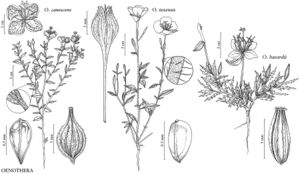Oenothera havardii
Proc. Amer. Acad. Arts 20: 366. 1885. (as havardi)
Herbs compact to sprawling, strigillose; from a taproot, lateral roots producing adventitious shoots. Stems usually many-branched, sometimes unbranched, often twining among vegetation, sometimes rooting at nodes, 5–25(–70) cm. Leaves in a basal rosette and cauline, basal usually quickly deciduous, (1–)2–5 × (0.2–)0.5–1.5 cm; petiole 0–0.6 cm; blade oblanceolate, linear-lanceolate to linear distally, margins few toothed to pinnately lobed to sinuate-dentate distally. Flowers 1–few opening per day near sunset; buds often twisted, free tips coherent; floral tube (37–)45–60(–65) mm; sepals (16–)18–26(–30) mm; petals lemon-yellow, fading orange-red to reddish purple, usually elliptic, sometimes oblanceolate, (18–)21–30(–32) mm; filaments 15–18(–22) mm, anthers red, 6–13 mm; style (55–)65–86(–94) mm, stigma exserted beyond anthers at anthesis. Capsules woody, narrowly ovoid to ovoid, 4-angled, 8–13(–16) × 3–4 mm, apex tapering to a short sterile beak 2–3 mm, valves with a prominent, broad midrib and capsule appearing 8-ribbed, tardily dehiscent ca. 1/3 capsule length. Seeds 2–2.5(–3.3) × 1.2–1.5 mm, sometimes with a small wing at distal end or a raised ridge along one longitudinal margin. 2n = 14, 28.
Phenology: Flowering Apr–Oct.
Habitat: In depressions, seasonally wet flats, stream banks, margins of irrigated fields, sandy or clay soil, among tufted grasses like Sporobolus wrightii, primarily in Chihuahuan Desert.
Elevation: 1300–2000 m.
Distribution
Ariz., Tex., Mexico (Chihuahua, Durango, Sonora, Zacatecas).
Discussion
Oenothera havardii ranges from Brewster and Presidio counties, Texas, and Cochise County, Arizona, south to Durango and Zacatecas, Mexico. W. L. Wagner (1984) found that O. havardii is self-incompatible and vespertine.
Selected References
None.
